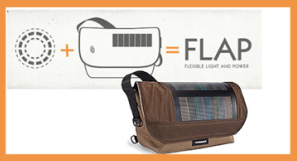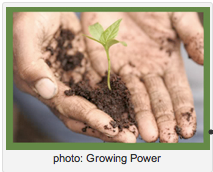But first, a little music. Logan Richardson’s soulful, playful, questioning sax riffs on “America the Beautiful” one day. Zoe Keating’s clear, deeply layered, architecturally precise, transcending cello pieces another. How lovely to start each day by notthinking. Just being. In the moment. Together. Brilliant.
And then it was off and running, from economics to education, urban decay to urban agriculture, environmental catastrophe to conservation hope, design theory to food design, cardboard robots to paper diagnostics, communications to comics, art to dance to music. To, to, to…
TAKE-AWAYS
Throughout the conference, Michelle Riggen-Ransom, Rachel Barenblat, and Ethan Zuckerman were absolutely brilliant live-blogging the talks. Read their posts, along with Kristen Taylor’s, on the PopTech blog to get a more detailed view of goings on.
Among the overarching themes: the serendipity of the amateur and the common sense of a cross-disciplinary approach. In short, the easiest way to see outside the box is to be outside the box.
For preventive medicine pioneer Dean Ornish, the shift from the “fear of dying to the joy of living is the key to the healthier future. For materials scientist Neri Oxman, it is moving from a Miesian reality where each building material has a specific function (steel for support, glass for light) to one inspired by Nature, where a single material yields a range of benefits (e.g., the structure of an egg shell evolved to provide strength as well as gas permeability). For clinical psychologist, Naif Al-Mutawa, it is tackling Muslim stereotypes through the compelling comic book stories of Muslim superhero kids (“The 99″). Better is better.
- Will Allen is a teacher and an inspiration for the potential of urban agriculture. His suite of Growing Power farms in Milwaukee and Chicago are designed as a series of nested ecosystems. Vermicomposting – turning garbage into wildly fertile worm castings – is the lynchpin. You start by creating soil so rich, it doesn’t require petro-based chemical additives. From aquaponics set ups to raise fish by the thousands to a biodigester for converting food waste into energy, everything that can be harvested or recycled is. It is cleaner, healthier, oil-independentfood system, with local “farm to fork” distribution networks designed to turn urban “food deserts” green.
- Willie Smits has plans for a similar polyculture fix, only rainforest-size. Trained in forestry, Smits career took a turn when he came across a sick orangutan in a Borneo market. Saving orangutans meant saving habitat, an increasingly difficult task when easy profits for palm oil led to wholesale conversion of ancient forests into modern superficially-efficient monocultures. Beyond the staggering loss of biodiversity, forest clearing fires, especially in peat-land forests, have led to “CO2 volcanoes,” spewing vast amounts of sequestered greenhouse gases skyward. Smits’ fix centers around the sugar palm, a short tree common in second-growth forest, which thrives only when grown as part of a polyculture and has a talent both for sequestering carbon (deep roots) and gushing a liquid that can be turned into sugar or ethanol. Smits has come up with a way to process the quick-to-ferment “juice” efficiently off-site. With the “juice” as the economic anchor, a suite of other forest products can also be sustainably harvested. Recently Smits set up a company, Tapergy, to implement his ideas. Notably, both Smits and Allen focus on jobs. Commodity monocultures destroy jobs and communities. Urban agriculture and tropical agroforestry create them.
- Chemist Daniel Nocera, by contrast, doesn’t want to raise plants but mimic them to generate vast amounts of energy. His epiphany: Plants routinely rebuild the mechanisms for splitting water in their leafy “fuel cells.” Scientists’ decades-long quest to find stable catalysts was not only futile but utterly misguided. Instead, his lab developed a resilient catalyst that could rebuild itself, making it possible to create both a better, cheaper fuel cell and process dirty water into drinkable water.
Perhaps the most exciting announcement at the conference was about a new fellows program for scientists, which takes us back to cross-disciplinary common sense. As the speaker list already demonstrates, science is an essential part of creating change for the greater good.
| |
1) Develop a session or a workshop focused on tech transfer, focusing on both the legal and marketing angles.
2) Add data visualizations to the program and on the website showing connections between speakers. With such a multi-disciplinary list, connections transcend program groupings. For example, Smits could just as logically been grouped with Michael Pollan and Will Allen.
3) Open the PopTech Creative Reuse Workshop at 8 a.m., one hour before the conference. Put out coffee as bait for early risers. I completely missed the workshop. The daily speaker sessions tended to go long, so there wasn’t much time to scoot over afterward. During breaks, the tendency was to mingle, network and nosh on site. Restaurants chosen for lunches were all located in the opposite direction.
4) Develop an online book store search-able by title, author and subject.
Now to wait for the videos to post, just in time for the long winter/cozy season…
| | I created a "Pop-tracker" using a prototype custom aggregation tool. I was able to generate as many categories and sub-categories as needed. Each sub-category includes several links which are stored in a drop down format. Each link has a mouse-activated pop-up with information about the resource. |












